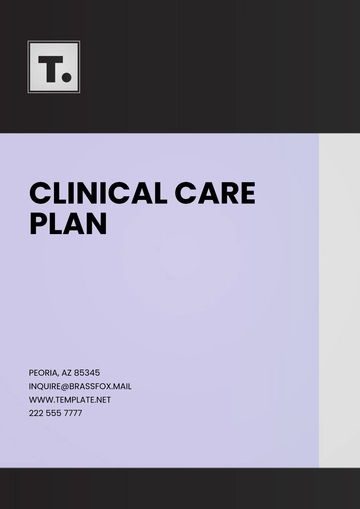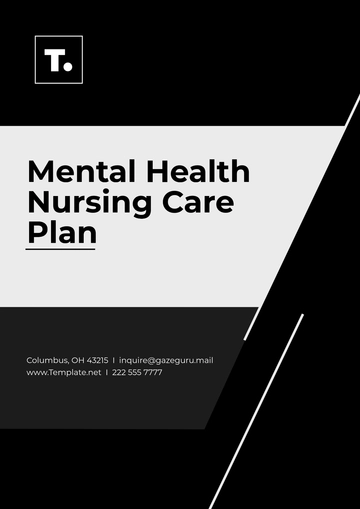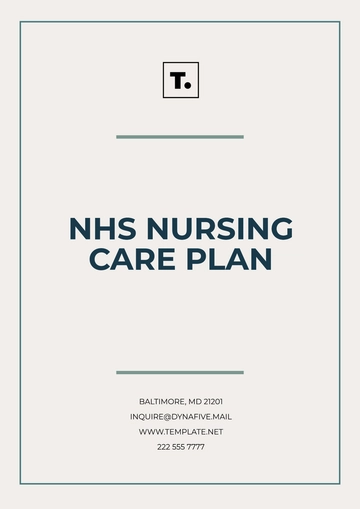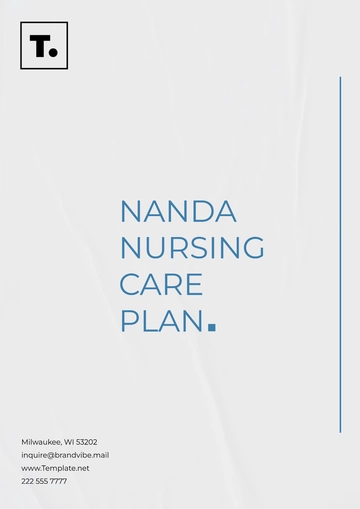Free Nursing Home Resident Care Plan
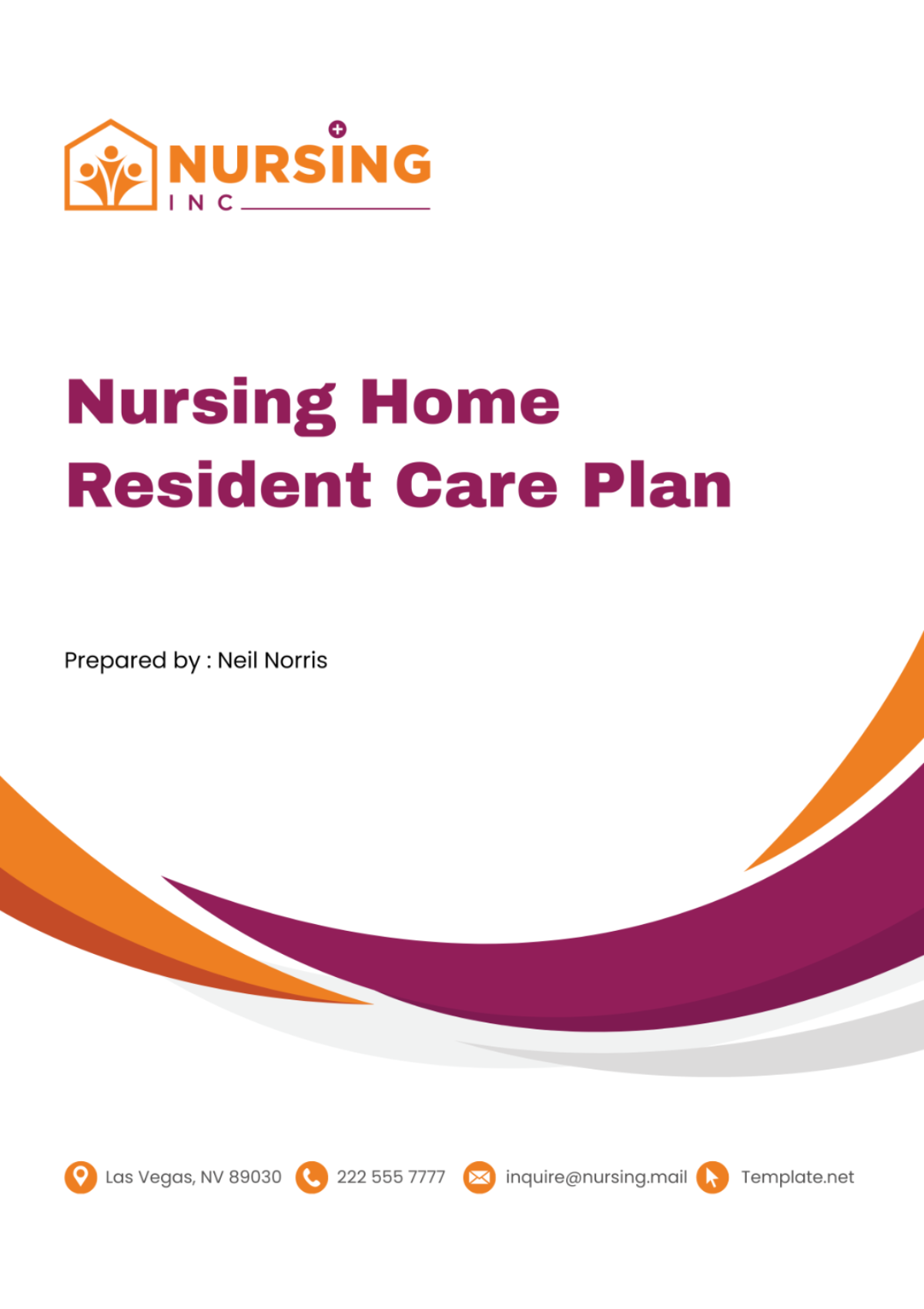
A. Resident Profile
In the Resident Profile section, we compile crucial personal details and pertinent information about each resident. This section serves as the cornerstone for delivering personalized care within our facility. By meticulously documenting the resident's background, medical history, and unique needs, our caregivers can provide tailored support that respects individuality and enhances overall well-being. Through this structured approach, we ensure a comprehensive understanding of each resident's requirements and preferences, fostering a nurturing environment conducive to their health and comfort.
Resident Profile Table:
Information | Details |
|---|---|
Name: | |
Age: | |
Gender: | |
Date of Birth: | |
Medical History: | |
Allergies: | |
Primary Diagnosis: | |
Special Considerations: |
B. Comprehensive Assessment
The Comprehensive Assessment section serves as a thorough examination of the resident's holistic well-being, encompassing physical, mental, emotional, and social dimensions. Through meticulous documentation of various aspects such as functional abilities, cognitive status, and psychosocial factors, we gather crucial insights to tailor our care strategies effectively, ensuring optimal resident outcomes.
Aspect | Details |
Physical Health | |
Functional Abilities: | Able to perform activities of daily living independently, with occasional assistance for mobility. |
Mobility: | Uses a walker for ambulation and requires assistance with transfers. |
Vital Signs: | Blood pressure: 120/80 mmHg, Pulse: 72 bpm, Temperature: 98.6°F, Respiratory Rate: 16 breaths/min. |
Mental Health | |
Cognitive Status: | Alert and oriented to person, place, and time. Exhibits mild forgetfulness but can engage in meaningful conversations. |
Mood and Behavior: | Generally cheerful and cooperative. Occasionally exhibits signs of frustration when unable to recall recent events. |
Emotional Well-being | |
Emotional State: | Appears content and relaxed during interactions. Expresses occasional feelings of loneliness. |
Coping Mechanisms: | Coping Mechanisms: Relies on hobbies such as reading and gardening to manage stress. |
Social Needs | |
Communication Skills: | Able to communicate effectively with staff and peers. Uses hearing aids for mild hearing impairment. |
Social Engagement: | Enjoys participating in group activities and outings. Maintains close relationships with family members who visit regularly. |
Support Systems: | Receives emotional support from family and friends. Engages with religious community for spiritual guidance. |
Cultural Considerations: | Observes dietary preferences in accordance with cultural beliefs. Respects cultural traditions and practices. |
C. Personalized Objectives
In this section, we delineate specific and actionable goals tailored to meet the resident's unique needs and preferences, as identified through the comprehensive assessment. These objectives are crafted to be specific, measurable, attainable, relevant, and time-bound (SMART), ensuring a clear pathway towards enhancing the resident's overall well-being.
Our overarching aim is to enhance the resident's quality of life by addressing key areas such as improving mobility, managing pain effectively, promoting cognitive function, nurturing emotional well-being, and fostering meaningful social engagement. By setting clear and achievable objectives, we empower the resident to actively participate in their care journey, fostering a sense of ownership and empowerment. Through regular monitoring, reassessment, and adjustment, we remain steadfast in our pursuit of optimizing the resident's overall health, happiness, and satisfaction within our compassionate care community.
D. Intervention Plans
In the Intervention Plans section, we delineate the specific care strategies tailored to meet the resident's individualized goals and address their unique needs. Through a comprehensive approach encompassing various elements of care, including medical treatments, nursing needs, dietary requirements, medication management, and psychosocial support services, we aim to optimize the resident's overall well-being.
Intervention Plans Table:
Intervention | Rationale | Expected Outcome |
|---|---|---|
Medical Treatments | Administering pain medication as prescribed to alleviate discomfort and promote mobility. | Reduction in pain intensity, allowing for improved mobility and quality of life. |
Nursing Care | Providing assistance with activities of daily living (ADLs) to ensure safety and maintain independence. | Enhanced functional abilities and self-esteem through successful completion of ADLs. |
Dietary Requirements | Implementing a balanced diet rich in nutrients to support overall health and well-being. | Improved nutritional status, leading to enhanced energy levels and immune function. |
Medication Management | Administering medications as prescribed, monitoring for potential side effects, and ensuring adherence to the treatment regimen. | Effective management of medical conditions, minimizing adverse reactions and promoting therapeutic outcomes. |
Psychosocial Support | Facilitating social interactions and engagement in meaningful activities to combat feelings of loneliness and promote emotional well-being. | Increased social connectedness and emotional resilience, fostering a sense of belonging and purpose. |
E. Care Schedule
In the Care Schedule section, we detail the specifics of care delivery, including the frequency of medication administration, therapy sessions, personal care tasks, and other routine care activities. Proper scheduling and meticulous planning are essential to ensure the provision of timely and adequate care, aligning with the resident's individual needs and preferences.
Activity | Frequency | Time |
|---|---|---|
Medication Administration | Twice daily | 9:00 AM, 5:00 PM |
Therapy Sessions | Three times per week | Monday, Wednesday, Friday |
Personal Care Tasks | Daily | Morning and evening |
Meal Times | Three times per day | 8:00 AM, 12:00 PM, 6:00 PM |
Vital Sign Monitoring | Once per shift | Beginning of each shift |
Social Activities | Weekly | Thursday afternoons |
F. Monitoring Strategies
In the Monitoring Strategies section, we outline the tools and criteria for systematically tracking the resident's progress and evaluating the effectiveness of their care plan. By establishing clear parameters for monitoring outcomes and documenting changes in the resident's condition, we empower the healthcare team to make informed decisions and adapt the care plan as needed to ensure its continued effectiveness and relevance.
1. Assessment Tools
We utilize standardized assessment tools such as the Mini Mental State Examination (MMSE) for cognitive function, the Katz Index of Independence in Activities of Daily Living (ADLs) for functional status, and the Geriatric Depression Scale (GDS) for mood assessment.
2. Monitoring Parameters
Key parameters including vital signs, pain levels, medication adherence, and progress towards established goals are monitored regularly and documented according to established protocols.
3. Evaluation Criteria
Outcomes are evaluated based on predefined criteria, such as improvements in mobility, reduction in pain intensity, enhanced social engagement, and overall quality of life.
4. Documentation Process
Changes in the resident's condition, responses to interventions, and any modifications to the care plan are documented accurately and comprehensively in the resident's medical records.
5. Interdisciplinary Collaboration
Regular interdisciplinary team meetings are conducted to review the resident's progress, discuss any concerns or changes in their condition, and collaborate on adjustments to the care plan as needed.
6. Resident Feedback
Feedback from the resident and their family members is solicited and incorporated into the monitoring process, ensuring that their preferences, concerns, and goals remain central to the care planning process.
Through these monitoring strategies, we uphold our commitment to providing high-quality, person-centered care that promotes the well-being and enhances the quality of life for each resident under our care.
G. Communication Framework
In the Communication Framework section, we establish guidelines to foster effective communication and collaboration among healthcare team members, ensuring the delivery of unified and seamless care. By delineating clear protocols for sharing information, delegating responsibilities, and coordinating care provisions, we strive to promote a culture of teamwork and accountability within our facility.
1. Information Sharing
Documentation Standards
Standardized formats and templates are used for documenting resident information, assessments, care plans, and progress notes to ensure clarity and consistency.
Electronic Health Records (EHR)
Utilization of an electronic health record system enables real-time access to resident information, facilitating efficient communication among team members.
2. Delegation of Responsibilities
Role Clarification
Each team member's roles and responsibilities are clearly defined, ensuring accountability and minimizing confusion.
Supervision and Oversight
Supervisory staff provide guidance and oversight to ensure tasks are delegated appropriately and executed effectively.
3. Coordination of Care Provisions
Interdisciplinary Team Meetings
Regular meetings are scheduled to discuss resident care plans, address concerns, and coordinate interventions across disciplines.
Care Conferences
Periodic care conferences involving the resident, family members, and relevant healthcare professionals provide an opportunity to review progress, adjust goals, and address any issues or concerns.
4. Communication Channels
Verbal Communication
Direct and open communication among team members, utilizing techniques such as bedside handovers and huddles, facilitates timely information exchange and problem-solving.
Written Communication
Use of secure messaging systems, email, and memos ensures clear and documented communication of important updates, instructions, and reminders.
5. Resident and Family Engagement
Regular Updates
Providing regular updates to residents and their families on care plans, treatment progress, and any changes in condition fosters transparency and trust.
Encouraging Feedback
Soliciting feedback from residents and families on their care experience enables continuous improvement and ensures their needs and preferences are prioritized.
H. Grievance Redressal Mechanism
n alignment with our commitment to ensuring the well-being and satisfaction of our residents, we have established a transparent and efficient Grievance Redressal Mechanism. Residents and their families are encouraged to voice any concerns or complaints they may have, and we are dedicated to addressing them promptly and effectively. The following procedure outlines the process for filing grievances and resolving issues:
Filing a Complaint ↓ Investigation and Documentation ↓ Resolution and Follow-Up ↓ Feedback and Continuous Improvement |
1. Filing a Complaint
Residents or their representatives can submit a complaint either verbally or in writing to the designated Grievance Officer. Complaint forms will be readily available throughout the facility for easy access. Alternatively, complaints can be lodged via phone or email.
2. Investigation and Documentation
Upon receipt of a complaint, the Grievance Officer will initiate a thorough investigation into the matter. This may involve gathering relevant information, conducting interviews with involved parties, and reviewing pertinent documentation. All findings and actions taken will be documented for transparency and accountability.
3. Resolution and Follow-Up
Once the investigation is complete, efforts will be made to resolve the complaint in a timely and satisfactory manner. This may include implementing corrective measures, providing apologies or explanations, or offering appropriate compensation if warranted. The Grievance Officer will communicate the outcome of the resolution to the complainant and ensure that any necessary follow-up actions are taken.
4. Feedback and Continuous Improvement
After the resolution of the grievance, residents and their families will be invited to provide feedback on their satisfaction with the handling of the complaint. This feedback will be used to identify areas for improvement in our processes and procedures, ensuring that similar issues are prevented in the future and that our residents receive the highest standard of care and service.
I. Technology in Care
In the modern era, leveraging technology can significantly enhance the provision of care in nursing homes. This section highlights various technologies that aid caregivers in providing, documenting, and tracking the progress of the care plan.
Electronic Health Records (EHR)
Telemedicine Platforms
Medication Management Systems
Wearable Health Monitoring Devices
Mobile Applications for Care Coordination
J. Health and Safety Standards
In adherence to stringent health and safety standards, caregivers must uphold protocols to ensure the well-being and security of residents within the facility. The following guidelines outline key areas of focus to maintain a safe and wholesome environment:
1. Infection Control
Regular hand hygiene practices and proper use of personal protective equipment (PPE) to prevent the spread of infections.
Routine cleaning and disinfection of high-touch surfaces and common areas to mitigate the risk of transmission.
2. Fall Prevention
Conducting comprehensive fall risk assessments for all residents and implementing personalized interventions to minimize fall hazards.
Ensuring adequate lighting, clear pathways, and assistive devices to enhance mobility and reduce fall risks.
3. Emergency Preparedness
Developing and regularly reviewing emergency response plans to effectively address various scenarios, including fires, natural disasters, and medical emergencies.
Conducting drills and training sessions to ensure staff readiness and resident safety during emergencies.
4. Nutrition and Dietary Safety
Adhering to dietary guidelines and individualized meal plans to meet residents' nutritional needs and accommodate dietary restrictions.
Safely handling, storing, and serving food to prevent contamination and foodborne illnesses.
5. Medication Safety
Following proper medication administration protocols, including accurate dosage, verification, and documentation to prevent medication errors.
Providing education to residents and caregivers on medication management and potential side effects to ensure safe and effective use.
- 100% Customizable, free editor
- Access 1 Million+ Templates, photo’s & graphics
- Download or share as a template
- Click and replace photos, graphics, text, backgrounds
- Resize, crop, AI write & more
- Access advanced editor
Optimize individual care with the Nursing Home Resident Care Plan Template from Template.net. This editable and customizable template outlines personalized care strategies for nursing home residents, addressing their specific health, emotional, and social needs. Editable in our Ai Editor Tool, it's crucial for ensuring comprehensive, compassionate care, promoting resident well-being, and improving quality of life in your nursing home setting.
You may also like
- Finance Plan
- Construction Plan
- Sales Plan
- Development Plan
- Career Plan
- Budget Plan
- HR Plan
- Education Plan
- Transition Plan
- Work Plan
- Training Plan
- Communication Plan
- Operation Plan
- Health And Safety Plan
- Strategy Plan
- Professional Development Plan
- Advertising Plan
- Risk Management Plan
- Restaurant Plan
- School Plan
- Nursing Home Patient Care Plan
- Nursing Care Plan
- Plan Event
- Startup Plan
- Social Media Plan
- Staffing Plan
- Annual Plan
- Content Plan
- Payment Plan
- Implementation Plan
- Hotel Plan
- Workout Plan
- Accounting Plan
- Campaign Plan
- Essay Plan
- 30 60 90 Day Plan
- Research Plan
- Recruitment Plan
- 90 Day Plan
- Quarterly Plan
- Emergency Plan
- 5 Year Plan
- Gym Plan
- Personal Plan
- IT and Software Plan
- Treatment Plan
- Real Estate Plan
- Law Firm Plan
- Healthcare Plan
- Improvement Plan
- Media Plan
- 5 Year Business Plan
- Learning Plan
- Marketing Campaign Plan
- Travel Agency Plan
- Cleaning Services Plan
- Interior Design Plan
- Performance Plan
- PR Plan
- Birth Plan
- Life Plan
- SEO Plan
- Disaster Recovery Plan
- Continuity Plan
- Launch Plan
- Legal Plan
- Behavior Plan
- Performance Improvement Plan
- Salon Plan
- Security Plan
- Security Management Plan
- Employee Development Plan
- Quality Plan
- Service Improvement Plan
- Growth Plan
- Incident Response Plan
- Basketball Plan
- Emergency Action Plan
- Product Launch Plan
- Spa Plan
- Employee Training Plan
- Data Analysis Plan
- Employee Action Plan
- Territory Plan
- Audit Plan
- Classroom Plan
- Activity Plan
- Parenting Plan
- Care Plan
- Project Execution Plan
- Exercise Plan
- Internship Plan
- Software Development Plan
- Continuous Improvement Plan
- Leave Plan
- 90 Day Sales Plan
- Advertising Agency Plan
- Employee Transition Plan
- Smart Action Plan
- Workplace Safety Plan
- Behavior Change Plan
- Contingency Plan
- Continuity of Operations Plan
- Health Plan
- Quality Control Plan
- Self Plan
- Sports Development Plan
- Change Management Plan
- Ecommerce Plan
- Personal Financial Plan
- Process Improvement Plan
- 30-60-90 Day Sales Plan
- Crisis Management Plan
- Engagement Plan
- Execution Plan
- Pandemic Plan
- Quality Assurance Plan
- Service Continuity Plan
- Agile Project Plan
- Fundraising Plan
- Job Transition Plan
- Asset Maintenance Plan
- Maintenance Plan
- Software Test Plan
- Staff Training and Development Plan
- 3 Year Plan
- Brand Activation Plan
- Release Plan
- Resource Plan
- Risk Mitigation Plan
- Teacher Plan
- 30 60 90 Day Plan for New Manager
- Food Safety Plan
- Food Truck Plan
- Hiring Plan
- Quality Management Plan
- Wellness Plan
- Behavior Intervention Plan
- Bonus Plan
- Investment Plan
- Maternity Leave Plan
- Pandemic Response Plan
- Succession Planning
- Coaching Plan
- Configuration Management Plan
- Remote Work Plan
- Self Care Plan
- Teaching Plan
- 100-Day Plan
- HACCP Plan
- Student Plan
- Sustainability Plan
- 30 60 90 Day Plan for Interview
- Access Plan
- Site Specific Safety Plan




